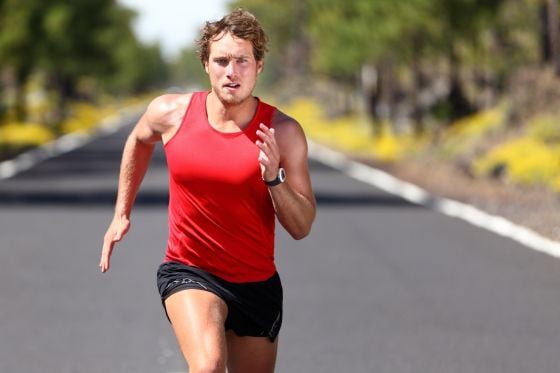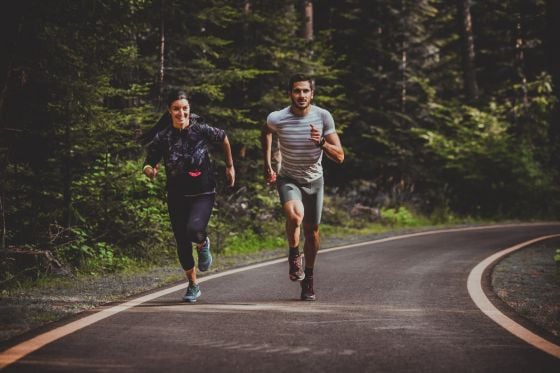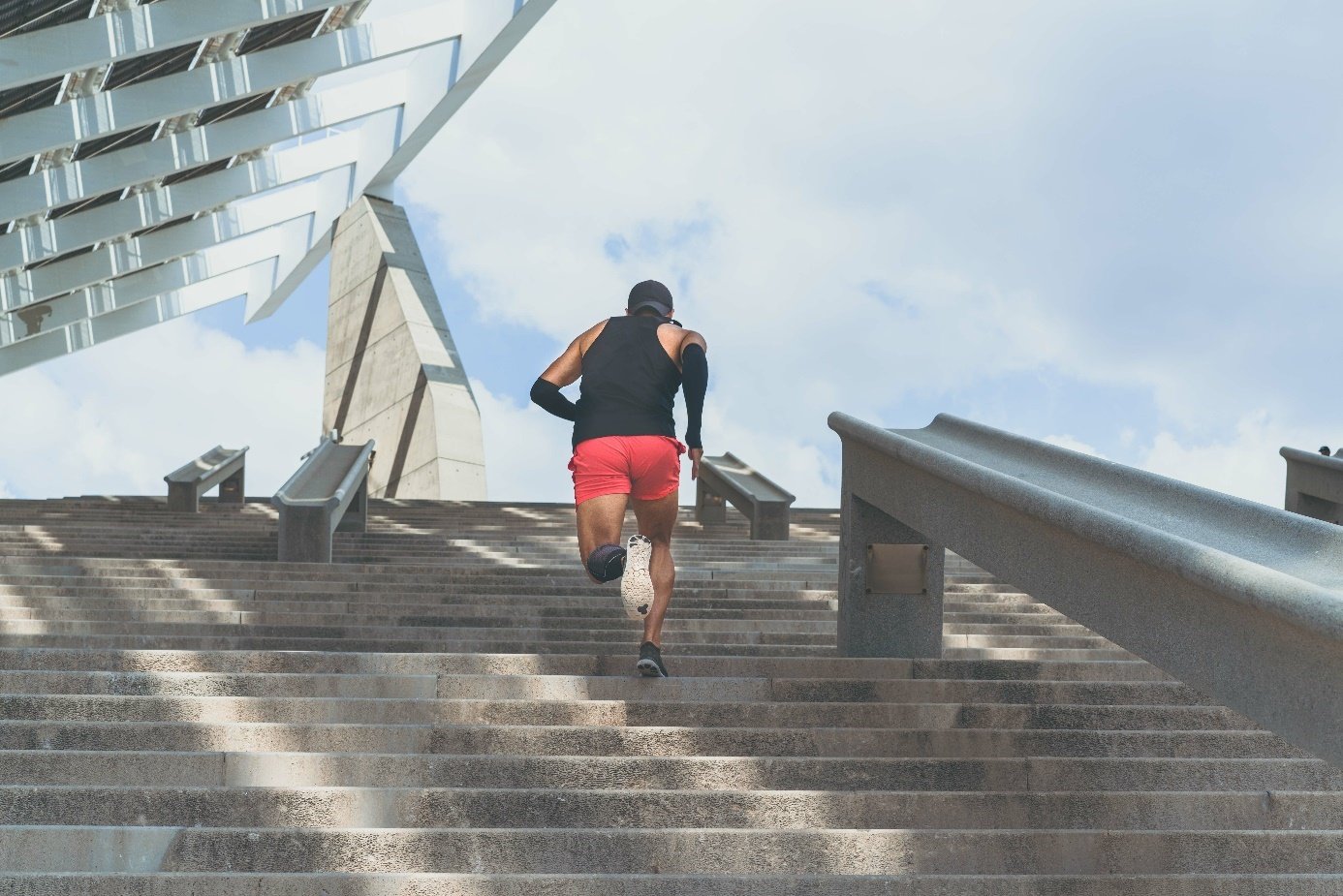Sprint Training: How to Kick it into High Gear
Tips & exercises for effective speed training

Yes, you can train sprinting. In this article, we explain how you can improve your speed with the right technique and targeted exercises. We also tell you what sprint training is and what benefits it has for your body and your athletic performance.
-
Contents of this article:
- What is sprint training?
- Advantages of sprint training
- Tips for successful speed training
- 4 effective exercises for your sprint training
What is sprint training?
With sprint training, an athlete trains their speed by running short distances at high speed. With short distance runs or sprints - you train in the anaerobic zone, because you have short and intensive phases of exertion. Your body draws energy exclusively from carbohydrate reserves without oxygen - in contrast to aerobic energy metabolism.
Sprint training is not just for track and field athletes. Even if you play soccer, tennis or basketball, you still need to cover short distances at high speed. Whether an athlete is a good sprinter often determines success or failure in their sport.
By the way: The fastest runner in the world is Jamaican Usain Bolt. In 2009, he ran 100 metres in just 9.85 seconds. The sprint star reached a top speed of 44.72 km/h in the process. The women's record for 100 metres is 10.49 seconds. The US American Florence Griffith-Joyner († 1998) set this in 1988.
Advantages of Sprint Training
We'll be honest: sprint training is exhausting and pushes your limits. But it's worth it and offers a number of benefits.
Increases metabolism (helps loose weight)
For years, amateur athletes were sold aerobic training as a miracle weapon for burning fat. However, research is now certain (Source: British Journal of Sports Medicine), that anaerobic training and therefore sprint training is more effective at burning fat. Without oxygen, the body doesn't burn fat during speed training, but training in a higher heart rate range increases energy consumption. This increases the absolute amount of calories burned. Sprint training also increases the afterburning effect on metabolism. This means that more calories than usual are burned in the hours following exercise.
You improve your endurance performance
If you incorporate sprints into your training again and again, you will benefit from better endurance in the long term. If you always run at the same level of intensity, your performance will stagnate as your body gets used to the strain. Anaerobic training, such as sprint training, on the other hand, creates new stimuli: every time you put your muscles under maximum strain when sprinting, they learn to process the lactate (lactic acid) that is produced better and faster. Your muscles tire more slowly and you become more efficient. So push your body with a few sprints from time to time. You will be rewarded with an improvement in your endurance performance after a few weeks. Interval training is great for runners!
You strengthen your mental fortitude
Sprint training will push you to your limits, not only athletically but also mentally. There will be times when you just want to stop and give up. But it's precisely in these moments that it's important to keep going and push yourself. You can be proud of yourself afterwards. Push through the pain. Afterwards, you'll be happy with your progress.
Sprint training is versatile
You want to try out sprint training, but running isn't your cup of tea? No problem. You can also do sprint training on your bike. Or you can incorporate sprints when training on the rowing machine or doing laps in the swimming pool.

Tips for successful speed training
We've put together some tips for you so that you're next training will go smoothly. That way, nothing will stand between you and getting fit.
Don't forget strength training
The body or musculoskeletal system is not designed for one-sided strain, as is the case when running. It needs stability from muscles and tendons. Strength training should therefore be part of your training routine.
In the following video, you will be shown a few strength training exercises that will get you running faster.
- Squats
- Calf Raises
- Step Ups
In addition to building muscle in your legs and buttocks, you should also strengthen your core. Here are two exercises that you can do in different variations:
- Planking
- Crunches
Tip: When doing crunches - unlike a sit-up - only lift your upper body off the floor enough to keep your lower back on the floor.

The best place for your speed training
You can do sprint training anywhere. However, it is best to run on level ground. This is because the risk of injury is rather high on uneven ground. At high speeds, the ankle joints are often put under a lot of strain and the risk of twisting your ankle is high. What's more, you don't have to concentrate on the path and watch out for roots, stones or uneven ground.
Do you have a track near you? Excellent. Because tracks are non-slip and you can complete your sprint training even when the surface is wet. The track allows you to push off explosively with every step. You can also use the marking lines to guide you during your run.

The right shoes for the right job
If you want to do your sprint training on a track in an athletics stadium or school sports field, it's worth buying cleats. Cleats have spikes that are attached to the soles of the shoes. With these shoes you have very good traction and avoid slipping. However, if you are planning to incorporate your sprint training into your regular jogging route, all you need are good running shoes. Learn how to find the right running shoes for your training in our magazine article.
Running school - train your technique
In addition to well-trained muscles, a good running technique is important for sprint training. To improve your running technique, you can use exercises from the sprint ABC and incline runs. We will explain both here.
Sprinting Drills
Athletes train individual aspects of movement with the sprint ABC exercises. These include hip, knee and ankle extension as well as knee lift - i.e. the accentuated lifting of the knee during the run -, arm use and an economical leg swing. The most important exercises are
- Ankle work: Take small steps forwards while doing high knees. Roll through the process of walking. Land with your heel and push off with your toes. At the moment you push off, the foot, knee and hip joints are stretched.
- High Knees: In this exercise, run with high knees. This time your movement will be faster and more explosive. Use your arms for support.
- Skipping: Walk forwards, when leaving a foot, bring the heel back to your butt. Tilt your upper body slightly forwards. The forward movement is rather slight and your hips are extended. Put your weight on the front of the foot.
In the following video, you can learn some running drills from a professional runner.
Incremental runs
Not only runners, but also other athletes, such as soccerers, basketball players and handball players, benefit from improved sprinting technique. Incremental runs are used to pay particular attention to the correct technical execution, such as arm use, knee lift and extension of the knee joint and hips, at a controlled speed.
Increase your speed evenly over a distance of around one hundred meters until you have reached around 80 to 90 percent of your maximum running speed after 60 to 80 meters. It is important that you only run fast enough to ensure that you are technically sound and don't cramp up. You can repeat the run after a short breather.
The right running posture
It's all about the right posture - even during sprint training. Make sure you straighten your body during the sprint. Bend forward only slightly and look straight ahead. Your head should form a direct extension of your spine. Your arms should be bent approximately at right angles in the direction you are running. The movement of the arms comes from the shoulder joint and they swing alternately as you run. Keep your pelvis and hips stable while sprinting.
Recharge your batteries before and after every workout
You munched on a chocolate bar before your workout because your stomach was growling and then regret it during training? We all know the feeling? We recommend that you eat foods that are easy to digest, especially before a sprint or running session. Also avoid large amounts of fiber, as this is difficult to digest. Your body is busy digesting and cannot put enough energy into your training.

How do you protect yourself from injury?
When sprinting, the body is exposed to high stress. It has to intuitively compensate for and stabilize many fast movements. It is therefore important to have a well-trained body. This allows you to optimally protect your muscles, tendons and ligaments. However, muscles and joints can only work well if they are trained. Therefore, be sure to incorporate flexibility training into your warm-up program.
4 effective exercises for your sprint training
What exercises can you do to get your legs moving quickly? We have put together four exercises or forms of training that you can use to improve your speed. Incorporate them independently into your running training once or twice a week or perform the exercises in isolation. After a few weeks, you will be able to celebrate your first successes.
Interval training
In interval training, phases of exertion and recovery alternate. The recovery intervals are designed in such a way that the body does not fully regenerate. The incomplete recovery sets a new training stimulus.
Whether you are a beginner or a sports professional, interval training is suitable for everyone. You can start after the run-in. This is how it works:
- The load phase should initially last around 15 seconds. During this time, you run at a pace that is 90 percent of your maximum sprint performance. Simply put: you are almost running at full throttle.
- Afterwards you rest: Then in 45 seconds, it starts again.
- Repeat this over the course of 15 minutes. You will then have completed 15 laps and your first interval training session. Bravo!
- Don't forget the cool down. Walk for about ten minutes at a moderate pace.
Ambitious athletes increase the time of the load and recovery phase.
If you want to read more about interval training, see our magazine article „Interval training: How to train the right way".

Incremental runs
With incline runs, you can kill two birds with one stone. This is because you not only train your technique, but also your speed.
- Over a relatively short distance - 80 to 120 meters - you slowly increase your running speed. You start with a slow endurance run and get faster and faster until you reach a sprint. You only sprint for the last 20 to 30 meters. Pay attention to your running technique while increasing your speed.
- After the first uphill run, continue running at a slow pace for one to two minutes and bring your heart rate back down.
- Then continue again at an increased rate.
- Repeat this four times. Next week, you can then increase to five repetitions.
After the last repetition, run for ten minutes at a pace that is comfortable for you.
Do what feels right
As the name suggests: Do what feels right by changing up the rules. Vary the speed and length of this exercise to suit your mood. Run fast or slow at any duration you want. You can do short sprints of 50 to 100 meters or run at a quick pace for up to three minutes. It's helpful if you set goals for yourself. For example, run to the next bench, to the next lamp post or from the next intersection.
Stairs
Running up stairs trains the same muscles that you use to sprint. These include the thigh, glutes, calves and the core. Stair running also trains your coordination skills. So look for a large staircase near you! You'll usually find stairs with many steps in public buildings, theaters or monuments.
If you're new to running up and down stairs, just focus on sprinting up the stairs but not back down. Instead, walk down the stairs and use the break to catch your breath.
- For your first stairs run, pick a staircase with around 30 to 50 steps and sprint up it.
- Repeat this six to eight times. When running up, make sure you only touch the ground briefly and only ever touch down with your front foot.
If you have a bit more experience and feel confident, then vary your speed when running up the stairs and try to take two steps at a time.
There's no excuse for avoiding running on stairs. You're bound to find a few while running your favorite jogging route.

Tip: You don't have to choose just one of these forms of training. Combine exercises with each other or incorporate several of these exercises into your weekly training plan.
Sprint training for success
Sprint training is not just for runners. Athletes from other disciplines also benefit greatly from speed training. Whether for soccer, handball, tennis or basketball, an athlete who can cover short distances quickly has an advantage. Sprint training often consists of various running exercises. If running is a thorn in your side, you can also adapt sprint training and do it on a rowing machine, bike or while swimming. However, you should'nt neglect technique training, especially when running. A proper running technique will help you prevent injury and help you reach a new personal best.
Sprint training is demanding. You'll need to grit your teeth a few times to get through the intervals and incline runs. Motivate yourself with new and comfortable sportswear - perhaps print your running shirt with a personal motivational saying? Take a look at our online store and design your personalszed shirt in our 3D Designer.
Good luck on your sprint training!
Image Credits: Title image: DimaBerlin/adobe.stock.com; Image 2: Maridav/adobe.stock.com; Image 3: splitov27/adobe.stock.com; Image 4: splitov27/adobe.stock.com; Image 5: Vladislav Noseek/adobe.stock.com; Image 6: oneinchpunch/adobe.stock.com; Image 7: KleverLevel/adobe.stock.com

